 BOE Vietnam Factory: Non-rigid Air Duct Solutions for Electronic Industry
BOE Vietnam Factory: Non-rigid Air Duct Solutions for Electronic Industry
 Why Fabric Air Ducts Are the Preferred Choice for Ventilation in Large Spaces
Why Fabric Air Ducts Are the Preferred Choice for Ventilation in Large Spaces
 The Difference Between Non-Rigid Air Ducts and Rigid Ductwork
The Difference Between Non-Rigid Air Ducts and Rigid Ductwork
Durkee ducts achieve the characteristics of small temperature difference in the area, control of the wind speed, shortened cooling time, noise reduction, quick installation, and simple maintenance by simulating the form of refrigeration through the pipe and extending the distance of the fan cooling supply. However, in the actual engineering design process, due to the blind pursuit of cost, the following problems in duct design often occur, which completely fail to reflect the advantages of fiber fabric air ducts and even affect the actual use of cold storage.
In order to save the cost of fiber fabric duct systems, some projects design the length of the ducts to be half or even shorter than the length of the warehouse, with the intention of relying on large nozzles at the end of the ducts to supply air to the remaining areas. Designing the length of the ducts to be half of the length of the warehouse without calculating the airflow and air pressure not only equals direct blowing and increases food consumption, but also results in insufficient end pressure and limited cross-sectional area at the end of the ducts, leading to a much lower actual air supply than the airflow required for that area.
Durkee fiber fabric air ducts are designed with professional solutions according to different types of cold storage: in high-temperature cold storage (0-5℃), for storing refrigerated fruits, vegetables, fresh eggs, and other food, in order to minimize the impact of airflow on the capacity of the storage (food consumption), Durkee ducts are usually designed to cover the entire length of the warehouse. Through the unique airflow mode of fiber permeation and micro-jet flow, the airflow is evenly distributed without drafts, and there are as few openings as possible at the end, reducing food consumption and minimizing temperature gradients within the storage to achieve rapid cooling and energy saving.
In low-temperature cold storage (-18℃~-25℃), for storing frozen meat, seafood, and other products, the low-temperature storage is generally used for long-term storage of packaged meat products, and it can tolerate a certain degree of air current sensation. Considering this characteristic, the length of Durkee ducts can be slightly reduced, and nozzles can be added at the end of the ducts to meet the airflow needs of the remaining distance. This solution saves space and reduces costs while meeting normal usage.
Durkee fiber fabric air ducts need to control the wind speed at the outlet of the fan between 9 and 10.5 m/s. If the size of the ducts is too small (to save material costs), the wind speed will be too high, causing the ducts to vibrate violently at the outlet, resulting in noise, increased wear at the interface, and shorter service life of the ducts. In order to avoid vibration caused by undersized ducts, some cases design the duct diameter to be smaller and open many large nozzles in the static pressure box for pressure relief. However, this will quickly remove the blown-out air when it is sucked in by the return air outlet behind the fan equipment, resulting in a loss of airflow and insufficient air and cooling capacity at the end, which is equivalent to reducing the designed air volume of the fan.
In the cold storage industry, different application conditions have different requirements for the permeability of fiber materials. Considering the characteristics of high airflow, low pressure, and low temperature in the cold storage industry, materials with a permeability rate of 40mm/s (144m3/h) or higher are usually selected. Fiber materials with high permeability can create a sufficient layer of cold air on the surface of the ducts, avoiding direct contact between the hot airflow entering when the warehouse doors open and the low-temperature walls of the ducts, thus preventing condensation. At the same time, the high permeability can ensure the smooth delivery of airflow by the fan at low pressure, preventing excessive pressure within the system.
Because many customers don't have much knowledge about fiber fabric duct systems, from the perspective of maintaining the industry, we remind customers to comprehensively investigate and evaluate from professional design solutions, material technology, and the scale and strength of the company in order to choose a good set of fiber fabric air duct systems and avoid taking on significant risks.